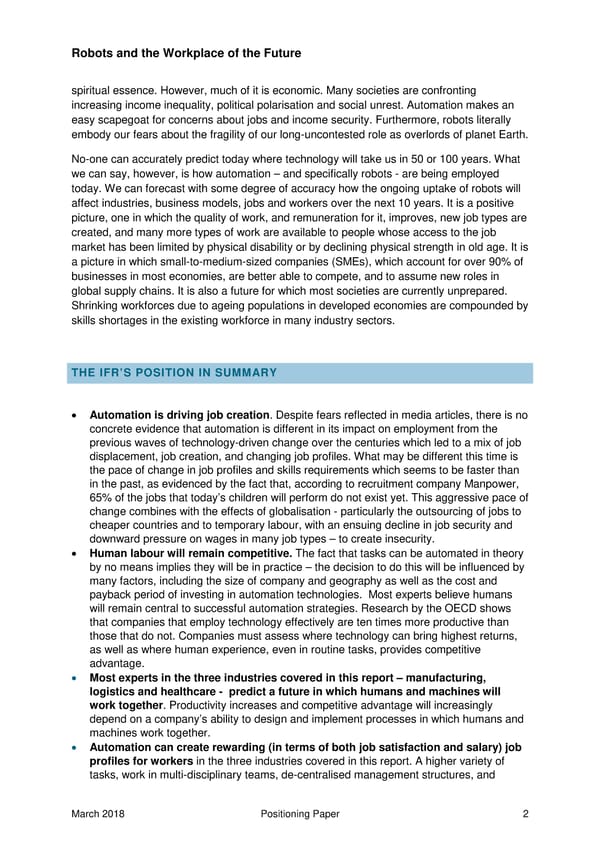Robots and the Workplace of the Future spiritual essence. However, much of it is economic. Many societies are confronting increasing income inequality, political polarisation and social unrest. Automation makes an easy scapegoat for concerns about jobs and income security. Furthermore, robots literally embody our fears about the fragility of our long-uncontested role as overlords of planet Earth. No-one can accurately predict today where technology will take us in 50 or 100 years. What we can say, however, is how automation – and specifically robots - are being employed today. We can forecast with some degree of accuracy how the ongoing uptake of robots will affect industries, business models, jobs and workers over the next 10 years. It is a positive picture, one in which the quality of work, and remuneration for it, improves, new job types are created, and many more types of work are available to people whose access to the job market has been limited by physical disability or by declining physical strength in old age. It is a picture in which small-to-medium-sized companies (SMEs), which account for over 90% of businesses in most economies, are better able to compete, and to assume new roles in global supply chains. It is also a future for which most societies are currently unprepared. Shrinking workforces due to ageing populations in developed economies are compounded by skills shortages in the existing workforce in many industry sectors. THE IFR’S POSITION IN SUMMAR Y • Automation is driving job creation. Despite fears reflected in media articles, there is no concrete evidence that automation is different in its impact on employment from the previous waves of technology-driven change over the centuries which led to a mix of job displacement, job creation, and changing job profiles. What may be different this time is the pace of change in job profiles and skills requirements which seems to be faster than in the past, as evidenced by the fact that, according to recruitment company Manpower, 65% of the jobs that today’s children will perform do not exist yet. This aggressive pace of change combines with the effects of globalisation - particularly the outsourcing of jobs to cheaper countries and to temporary labour, with an ensuing decline in job security and downward pressure on wages in many job types – to create insecurity. • Human labour will remain competitive. The fact that tasks can be automated in theory by no means implies they will be in practice – the decision to do this will be influenced by many factors, including the size of company and geography as well as the cost and payback period of investing in automation technologies. Most experts believe humans will remain central to successful automation strategies. Research by the OECD shows that companies that employ technology effectively are ten times more productive than those that do not. Companies must assess where technology can bring highest returns, as well as where human experience, even in routine tasks, provides competitive advantage. • Most experts in the three industries covered in this report – manufacturing, logistics and healthcare - predict a future in which humans and machines will work together. Productivity increases and competitive advantage will increasingly depend on a company’s ability to design and implement processes in which humans and machines work together. • Automation can create rewarding (in terms of both job satisfaction and salary) job profiles for workers in the three industries covered in this report. A higher variety of tasks, work in multi-disciplinary teams, de-centralised management structures, and March 2018 Positioning Paper 2
 Robots & the Workplace of the Future Page 2 Page 4
Robots & the Workplace of the Future Page 2 Page 4